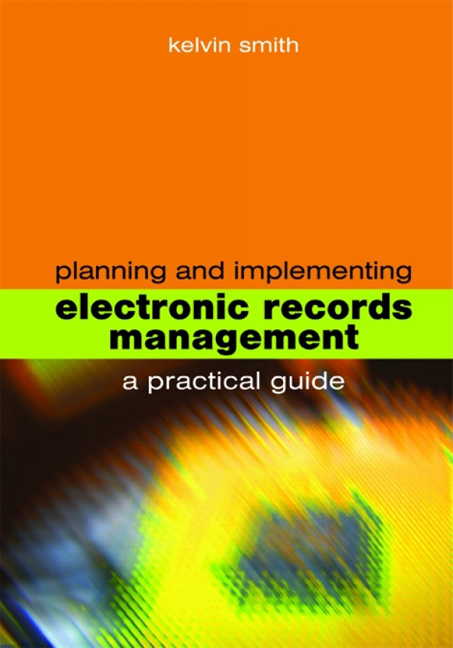10 - Main issues for implementation
from Part 3 - Implementation
Published online by Cambridge University Press: 08 June 2018
Summary
Designing the electronic records management system involves a great deal of technical planning and discussion. Implementation is a much more practical challenge. It will involve a great many management skills – project management, procurement, change management and training. All these are examined in the following chapters. This chapter looks at some general points relating to implementation, at particular issues that may affect it, such as hybrid records, e-mail and vital records, and at procedures for a post-implementation review.
The key aspect of the implementation of electronic records management, and its main objective, is to integrate the new system with current policies and practices so that as soon as possible it becomes the norm. This is quite a challenge. As the following chapters try to explain, it is not something that will happen overnight and it requires dedication and understanding by all parties concerned. The risks involved can be minimized through careful planning and documentation of the implementation process. In order to plan effectively, you will need to take into consideration several factors, such as organizational culture, current IT infrastructure, financial and other constraints, and overall business strategies. Implementation will vary from organization to organization but there will be several common activities:
• communication – keeping staff informed of progress, how the implementation affects them and where they can get advice
• making available policies and procedures relating to electronic records management
• evaluating available skills and organizing training events
• organizing support functions such as accommodation
• assigning and reviewing access rights to records
• issuing formal reports for management and project board members
• gathering information relating to implementation – take-up, user problems, change control, etc.
An underlying requirement, which has to be borne in mind at all times during implementation, is that information must always be readily available. The business of the organization cannot stop while machines are being configured, data is being converted, etc. This can, of course, be achieved technically but also needs to be planned carefully so that all users are confident that their working routines will not be unduly disrupted.
You may be interested in the following list whose contents have been garnered from a trawl of several websites on electronic records management projects.
- Type
- Chapter
- Information
- Planning and Implementing Electronic Records ManagementA practical guide, pp. 161 - 168Publisher: FacetPrint publication year: 2007



